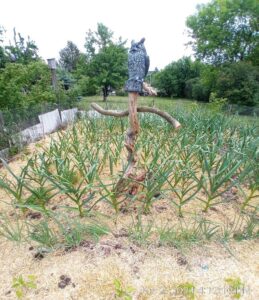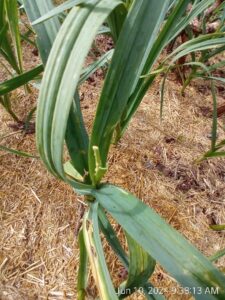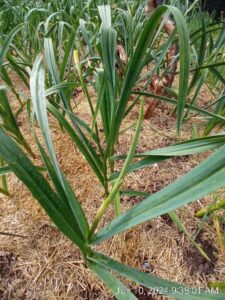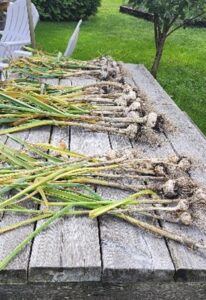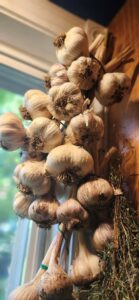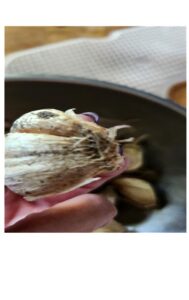Growing Garlic in Ontario – By Christine Westbrook
Types of garlic
There are many types of garlic that will grow in Ontario. I prefer to grow hard neck varieties such as Porcelain, Purple stripe, and Rocambole because I have had great success in the past, and they are easy to grow. Music is the most popular Porcelain because of its large cloves, hardiness, and storage length. It typically has a milder sweeter flavour. Russian Red is a popular purple stripe variety that is very hardy and has long storage abilities. Rocambole garlic is the choice of chefs due to its wonderful flavour, however it does not have great storage capabilities due to thin paper coverings. Russian Red is a Rocambole variety that has a very strong flavour and is hot when eaten raw.
Preparing soil
Soil should be well drained and amended with compost or manure. Dig trenches or make
holes so your cloves will be about 2-3 inches below the soil surface depending on their size. Larger cloves should be planted deeper. Sprinkle bone meal or super phosphate fertilizer in the trenches or holes to promote good root growth.
Planting
The cloves are planted with the pointed end facing upwards. Plant them 4 to 6 inches apart
depending on the size of the clove. The rows should be about 12 inches apart. Some varieties like Music will grow very large and need more space to grow. Spacing will also depend on how much room you have in your garden. The more space they have the larger they will grow because they will not be competing for nutrients. Water well after planting.
Mulching for winter- Garlic should have a thick layer of straw or leaves placed over it to protect it for the winter. I prefer to use leaves which will act as a mulch in spring but will then break down over the summer to add organic material and nutrients to my soil.
Spring care
Once the weather warms in the spring remove the mulch you used from around the emerging garlic but leave it in place to suppress weeds and help retain moisture. Weed and water as needed. I usually fertilize them in June with an all-purpose fertilizer when they are actively growing. We also dress them with more compost in early summer.
Actively growing garlic with straw and leaves as mulch
Scapes
In late June start to look for scape formation. The scapes need to be removed so the bulb will not use energy making seeds. They should be cut when there is a double loop on the stem of the scape and when the flower starts to swell. If you are late cutting, they may start to unwind. They need to be cut a few inches above the last leaf. Scape stems are very tasty and can be pickled or used for cooking. We make scape pesto by grinding them up with olive oil. If you want to reproduce by bulblets you can leave a few scapes on the plants to form the bulblets. Watch out for leek moth damage on the scape and remove them immediately so the larva does not hatch. Spraying with neem oil will help to get rid of any larva that hatch and start to feed on the scapes.
Leek moth damage
Harvesting
In late July to early August start to count the dying leaves. I find that different varieties are ready to harvest before others. I harvest when 3-4 leaves have died. If you leave it too long the protective paper covering over the cloves will become thin and they will not store as well. Harvest the bulbs when it has not rained for a few days so the soil will not be stuck to the bulbs. If there is a lot of soil stuck leave them to dry. It is not ideal to try to wash it off because this can harm the paper coverings. Remove as much soil as you can. They should be hung up in a dry ventilated area or placed on drying racks and allowed to cure for a few weeks. Once they are dry the rest of the soil can be removed using a soft brush, and they can be tied in bunches or braided.
Sorted garlic ready to dry
Storage
Garlic should be stored between 13-20 degrees Celsius with a humidity of 50-60% in an area with good air circulation. I braid mine and hang it up in my kitchen and basement. Keep an eye on it and if it is not keeping well, grind it up and freeze it or dry it and make garlic powder. I have had some of mine last until I can dig young bulbs in July.
Make sure to save your largest bulbs to replant in October when the harvest moon is out!.
Check for nematode damage, pictured in the above right picture. Buy new seed garlic if they do have damage and plant in a different spot from the previous year.
My garlic had leek moths and nematode damage this year. The roots were damaged, and some cloves are turning yellow. Some varieties fared better than others. My Mexican purple and Russian red were not affected, however almost all of my largest Music bulbs need to be replaced.
Happy planting!

